Computational Fluid Dynamics (CFD) Modeling and Analysis of Hydrocarbon Vapor Cloud Explosions (VCEs) in Amuay Refinery and Jaipur Plant Using FLACS
Abstract
1. Introduction
Literature Review
2. Background
2.1. Vapour Cloud Explosion (VCE)
2.2. Detonation and Deflagration
2.3. Affecting Parameters
2.3.1. Geometry Complexity
2.3.2. Ignition Source
- flames being exposed to the environment, such as flares;
- burning substances;
- solid surfaces have a high temperature;
- electrical sparks beside similar other means of discharge;
- confinement having an adiabatic situation.
2.3.3. Wind Effect
2.4. The Explosion at Punto Fijo Refinery, Venezuela
2.5. Explosion at Indian Oil Corporation’s (IOC) Jaipur Terminal, India
- loss of primary gasoline containment;
- escape of gasoline from secondary containment;
- the operating staff was ordained useless;
- lack of tools to tackle the situation;
- flaws in the engineering design;
- no team available for operating from the site and in the case of essential areas.
3. Modeling Methodology
3.1. Input Data for Simulation
4. Results and Discussion
5. Conclusions
Author Contributions
Funding
Institutional Review Board Statement
Informed Consent Statement
Data Availability Statement
Conflicts of Interest
References
- Woodward, J.L.; Pitbaldo, R. LNG Risk-Based Safety: Modeling and Consequence Analysis; John Wiley & Sons: Hoboken, NJ, USA, 2010. [Google Scholar]
- King, R.; Hirst, R. King’s Safety in the Process Industries; Butterworth-Heinemann: Oxford, UK, 1998. [Google Scholar]
- Tian, D.; Zhao, C.; Wang, B.; Zhou, M. A MEMCIF-IN method for safety risk assessment in oil and gas industry based on interval numbers and risk attitudes. Eng. Appl. Artif. Intell. 2019, 85, 269–283. [Google Scholar] [CrossRef]
- Casal, J. Evaluation of the Effects and Consequences of Major Accidents in Industrial Plants; Elsevier: Amsterdam, The Netherlands, 2017. [Google Scholar]
- Zhou, J.; Reniers, G. Modeling, and analysis of vapour cloud explosions knock-on events by using a Petri-net approach. Saf. Sci. 2018, 108, 188–195. [Google Scholar] [CrossRef]
- Oran, E.S.; Chamberlain, G.; Pekalski, A. Mechanisms and occurrence of detonations in vapor cloud explosions. Prog. Energy Combust. Sci. 2020, 77, 100804. [Google Scholar] [CrossRef]
- Johnson, D.M. The potential for vapour cloud explosions—Lessons from the Buncefield accident. J. Loss Prev. Process. Ind. 2010, 23, 921–927. [Google Scholar] [CrossRef]
- Venart, J. Flixborough: The Explosion and its Aftermath. Process. Saf. Environ. Prot. 2004, 82, 105–127. [Google Scholar] [CrossRef]
- Sharma, R.; Gurjar, B.; Wate, S.; Ghuge, S.; Agrawal, R. Assessment of an accidental vapour cloud explosion: Lessons from the Indian Oil Corporation Ltd. accident at Jaipur, India. J. Loss Prev. Process. Ind. 2013, 26, 82–90. [Google Scholar] [CrossRef]
- Mishra, K.B.; Wehrstedt, K.-D.; Krebs, H. Amuay refinery disaster: The aftermaths and challenges ahead. Fuel Process. Technol. 2014, 119, 198–203. [Google Scholar] [CrossRef]
- Schmidt, S.; Mishra, K.B.; Wehrstedt, K.-D. CFD based reproduction of Amuay refinery accident 2012. Chem. Eng. 2016, 48. [Google Scholar] [CrossRef]
- Dasgotra, A.; Teja, G.V.; Sharma, A.; Mishra, K.B. CFD modeling of large-scale flammable cloud dispersion using FLACS. J. Loss Prev. Process. Ind. 2018, 56, 531–536. [Google Scholar] [CrossRef]
- Mishra, K.B. The influence of volume blockage ratio on IOCL Jaipur explosion. J. Loss Prev. Process. Ind. 2018, 54, 196–205. [Google Scholar] [CrossRef]
- Xiao, H.; Duan, Q.; Jiang, L.; Sun, J. Effects of ignition location on premixed hydrogen/air flame propagation in a closed combustion tube. Int. J. Hydrog. Energy 2014, 39, 8557–8563. [Google Scholar] [CrossRef]
- Schaschke, A. Dictionary of Chemical Engineering; OUP Oxford: Oxford, UK, 2014. [Google Scholar]
- Sharma, R.K. A violent, episodic vapour cloud explosion assessment: Deflagration-to-detonation transition. J. Loss Prev. Process. Ind. 2020, 65, 104086. [Google Scholar] [CrossRef]
- Hansen, R.; Johnson, D.M. Improved far-field blast predictions from fast deflagrations, DDTs and detonations of vapour clouds using FLACS CFD. J. Loss Prev. Process Ind. 2015, 35, 293–306. [Google Scholar] [CrossRef]
- Yi, Y.; Xueqiu, H.; Geng, L.; Huia, W. Effect of meshy obstacle on methane gas explosion. Procedia Eng. 2011, 26, 70–74. [Google Scholar] [CrossRef][Green Version]
- Eckhoff, R.K. Explosion Hazards in the Process Industries; Gulf Professional Publishing: Cambridge, MA, USA; London, UK, 2016. [Google Scholar]
- Sinha, A.; Wen, J.X. A simple model for calculating peak pressure in vented explosions of hydrogen and hydrocarbons. Int. J. Hydrogen Energy 2019, 44, 22719–22732. [Google Scholar] [CrossRef]
- Atkinson, G.; Cowpe, E.; Halliday, J.; Painter, D. A review of very large vapour cloud explosions: Cloud formation and explosion severity. J. Loss Prev. Process. Ind. 2017, 48, 367–375. [Google Scholar] [CrossRef]
- Ohep, E. More than 100 Dead in PDVSA Amuay Explosion—CEO Fedecamaras Falcon. 5 September 2012. Available online: http://www.petroleumworld.com/storyt12090501.htm (accessed on 28 June 2020).
- The Global Barrel. Amuay Refinery Disaster: Syrian Naphtha & Chavez ’Petroleum Revolution’ in Flames. 30 August 2012. Available online: https://globalbarrel.com/2012/08/30/amuay-refinery-disaster-syrian-naphtha-chavez-petroleum-revolution-in-flames/ (accessed on 28 June 2020).
- Pearson, T. Venezuelan Report: Refinery Disaster Caused by Intentional Manipulation of Gas Pump Bolts. 10 September 2013. Available online: https://venezuelanalysis.com/news/10013 (accessed on 29 June 2020).
- Zhang, S.; Wang, X.; Cheng, Y.F.; Shuai, J. Modeling and analysis of a catastrophic oil spill and vapor cloud explosion in a confined space upon oil pipeline leaking. Pet. Sci. 2020, 17, 556–566. [Google Scholar] [CrossRef]
- Girdhar, M. Jaipur Fire and its Environmental effects. Fire Eng. 2012, 37, 21–22. [Google Scholar]
- Lal, M.B. Committee Report; Oil Industry Safety Directorate: Noida, India, 2015.
- Sharma, R.K.; Gurjar, B.R.; Ho, H.K.P.; Ghuge, S.P.; Agrawal, R. Lessons Learned from Industrial Chemical Accidents: A Case Study of Indian Oil Corporation (IOC) Terminal, Jaipur, India. 2015. Available online: https://pscmembers.tamu.edu/wp-content/uploads/2015/2015 Proceedings/045_Ravi Sharma.pdf (accessed on 29 June 2020).
- Hurley, M.J.; Gottuk, D.T.; Hall, J.R., Jr.; Harada, K.; Kuligowski, E.D.; Puchovsky, M.; Torero, J.L.; Watts, J.M., Jr.; Wieczorek, C.J. SFPE Handbook of Fire Protection Engineering; Springer: Berlin/Heidelberg, Germany, 2015. [Google Scholar]
- Dan, S.; Kim, H.; Shin, D.; Yoon, E.S. Quantitative Risk Analysis of New Energy Stations by CFD-Based Explosion Simulation. In Computer Aided Chemical Engineering; Elsevier: Amsterdam, The Netherlands, 2012; Volume 31, pp. 305–309. [Google Scholar]
- Gant, S.; Narasimhamurthy, V.; Skjold, T.; Jamois, D.; Proust, C. Evaluation of multi-phase atmospheric dispersion models for application to Carbon Capture and Storage. J. Loss Prev. Process. Ind. 2014, 32, 286–298. [Google Scholar] [CrossRef]
- Gant, S.E.; Atkinson, G.T. Buncefield Investigation: Dispersion of the Vapour Cloud; Health and Safety Laboratory Report, CM/06/13; Health and Safety Laboratory: Bootle, UK, 2006.
- Venart, J.E.S.; Rogers, R.J. The Buncefield explosion: Vapor cloud dispersion and other observations. IChemE Symp. Ser. Hazards 2011, 22, 519–527. [Google Scholar]
- Johnsen, R.; Ryum, S.R. Explosion, Fire and Structural Response Analysis. In Proceedings of the SPE International Conference on Health, Safety and Environment in Oil and Gas Exploration and Production, Stavanger, Norway, 26–28 June 2000. [Google Scholar]
- Ma, G.; Huang, Y.; Li, J. VCE Overpressure Prediction by CFD Modelling. In Risk Analysis of Vapour Cloud Explosions for Oil and Gas Facilities; Springer: Singapore, 2019; pp. 45–79. [Google Scholar]
- Hansen, O.R.; Gavelli, F.; Ichard, M.; Davis, S.G. Validation of FLACS against experimental data sets from the model evaluation database for LNG vapor dispersion. J. Loss Prev. Process. Ind. 2010, 23, 857–877. [Google Scholar] [CrossRef]
- Hansen, R.; Melheim, J.A.; Storvik, I.E. CFD-modeling of LNG dispersion experiments. In Proceedings of the AIChE Spring National Meeting, Houston, TX, USA, 22–27 April 2007. [Google Scholar]
- Sajid, Z.; Zhang, Y.; Khan, F. Process design and probabilistic economic risk analysis of bio-diesel production. Sustain. Prod. Consum. 2016, 5, 1–15. [Google Scholar] [CrossRef]
- Sajid, Z.; Khan, F.; Zhang, Y. A novel process economics risk model applied to biodiesel production system. Renew. Energy 2018, 118, 615–626. [Google Scholar] [CrossRef]
- Sajid, Z.; Khan, F.; Zhang, Y. Integration of interpretive structural modelling with Bayesian network for biodiesel performance analysis. Renew. Energy 2017, 194–203. [Google Scholar] [CrossRef]

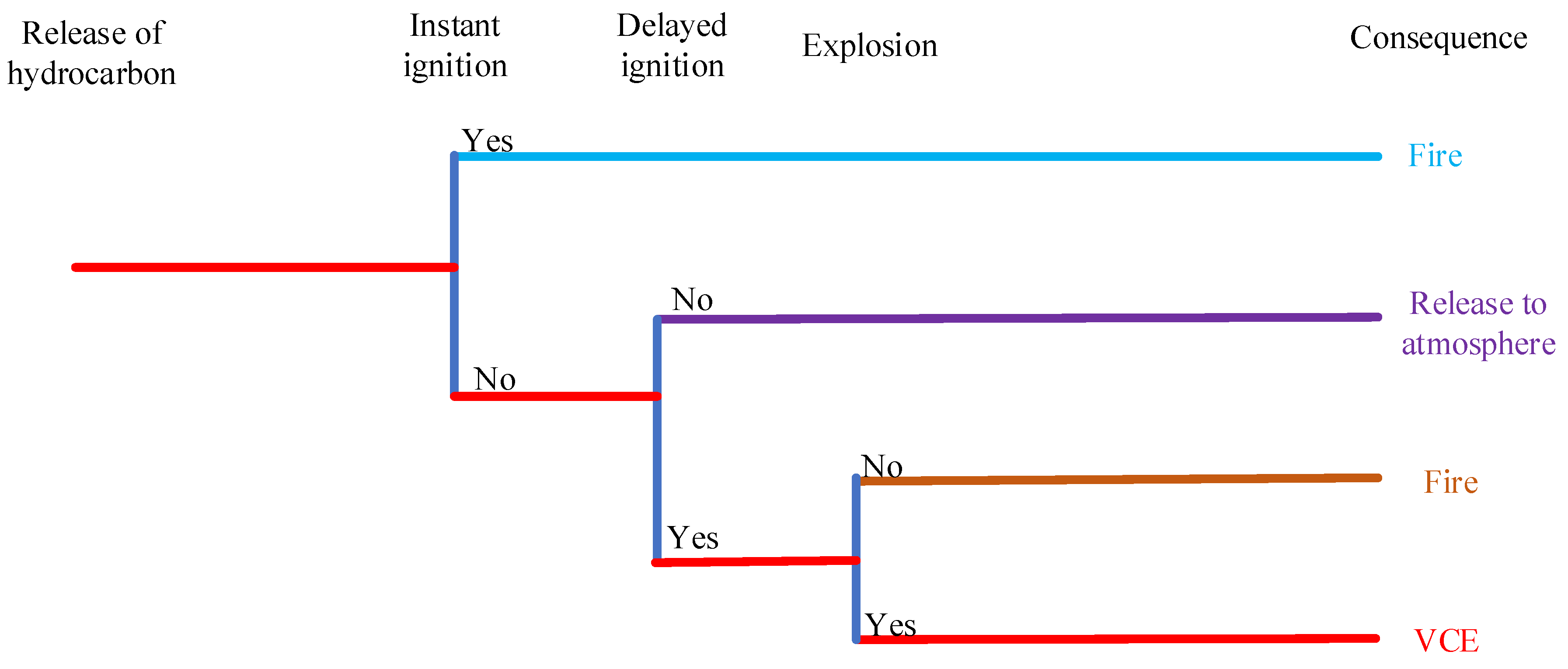
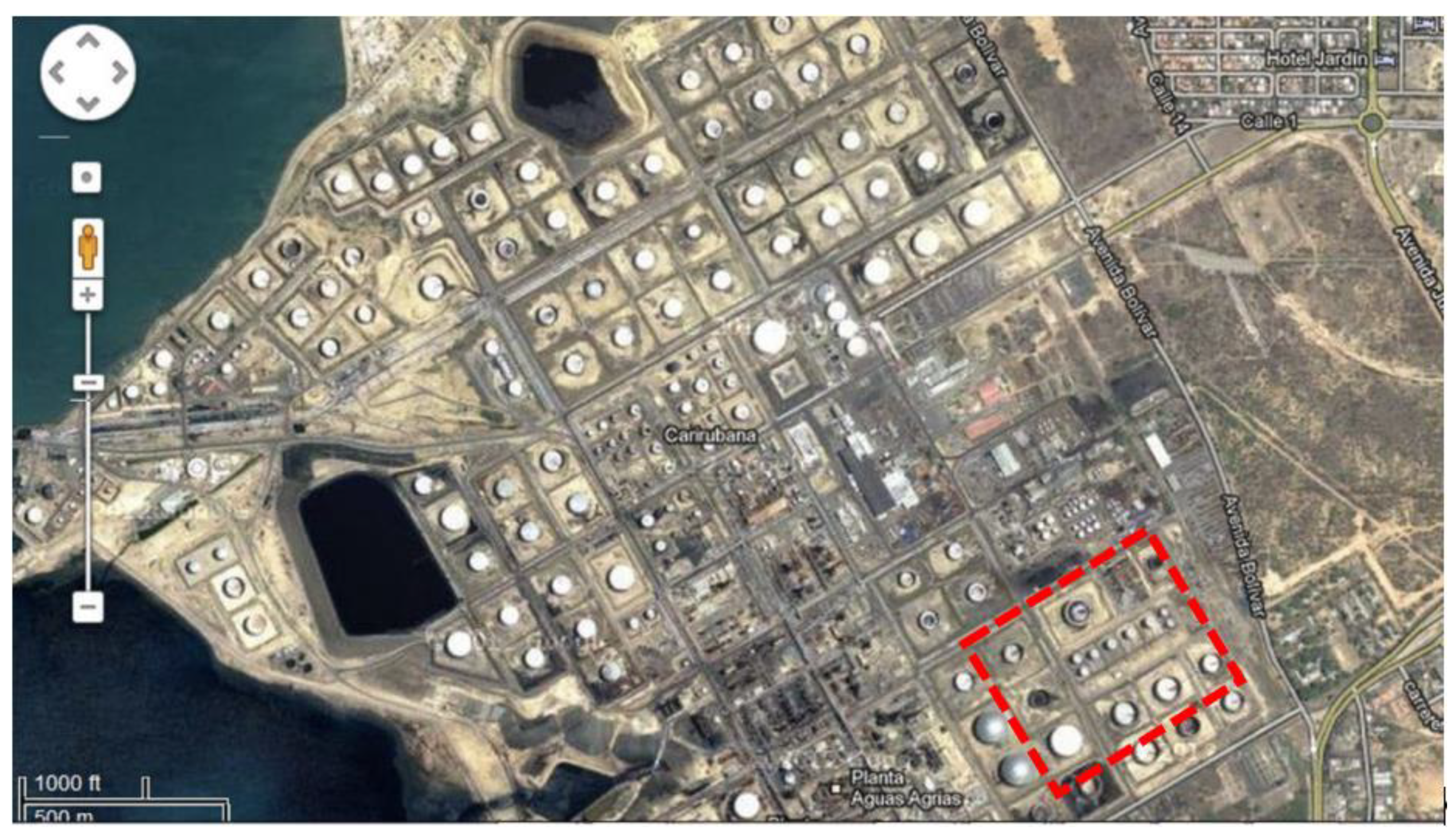
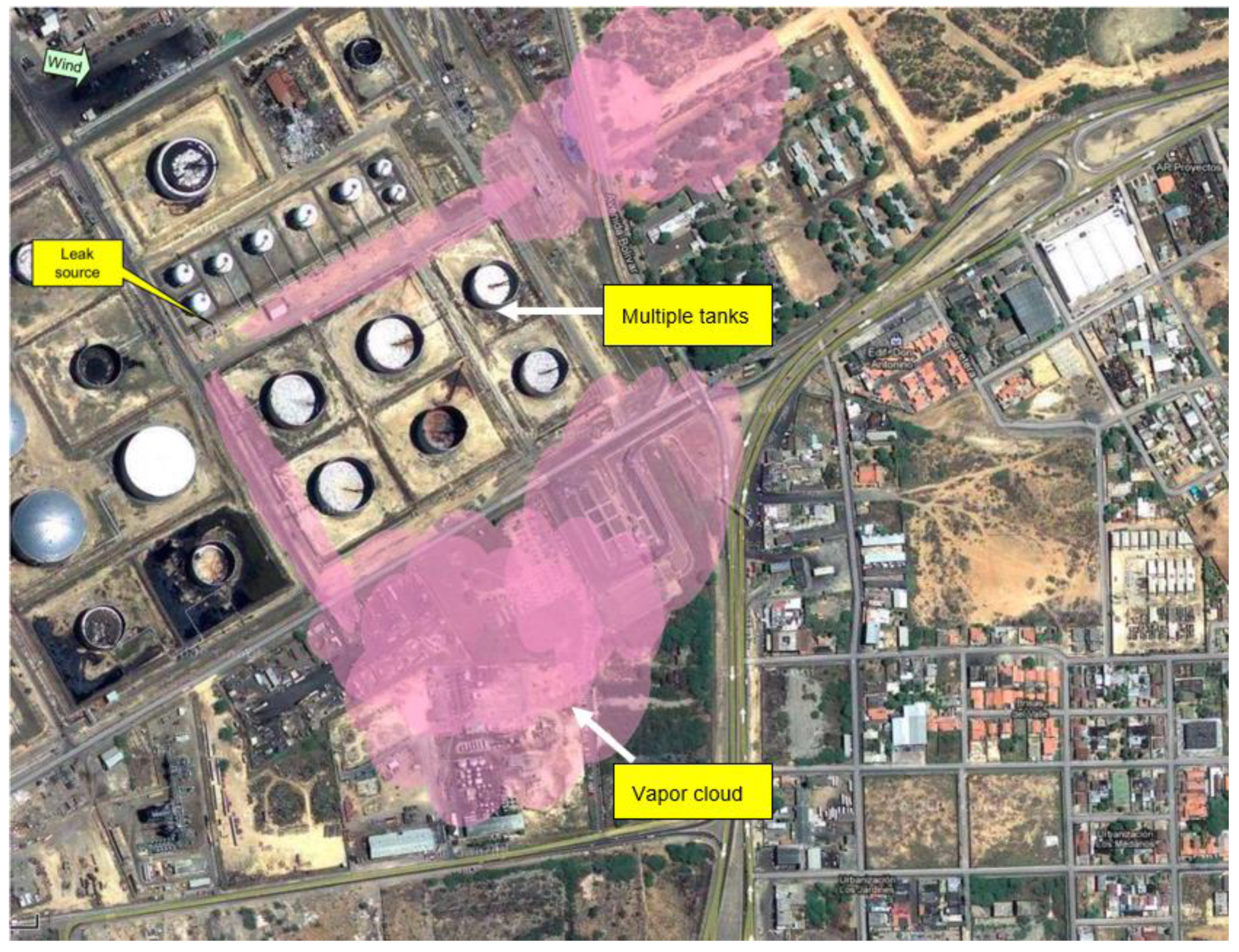
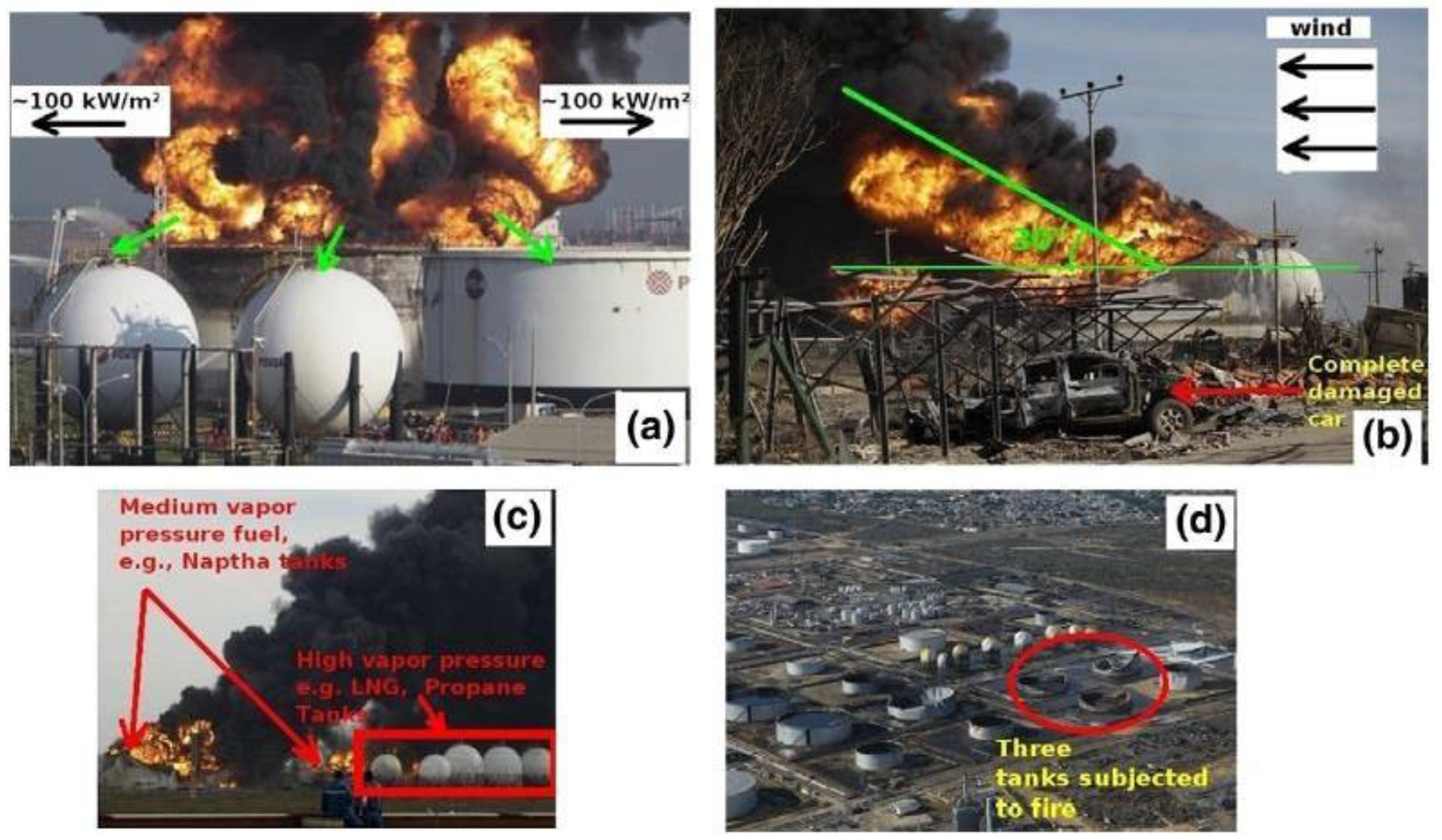
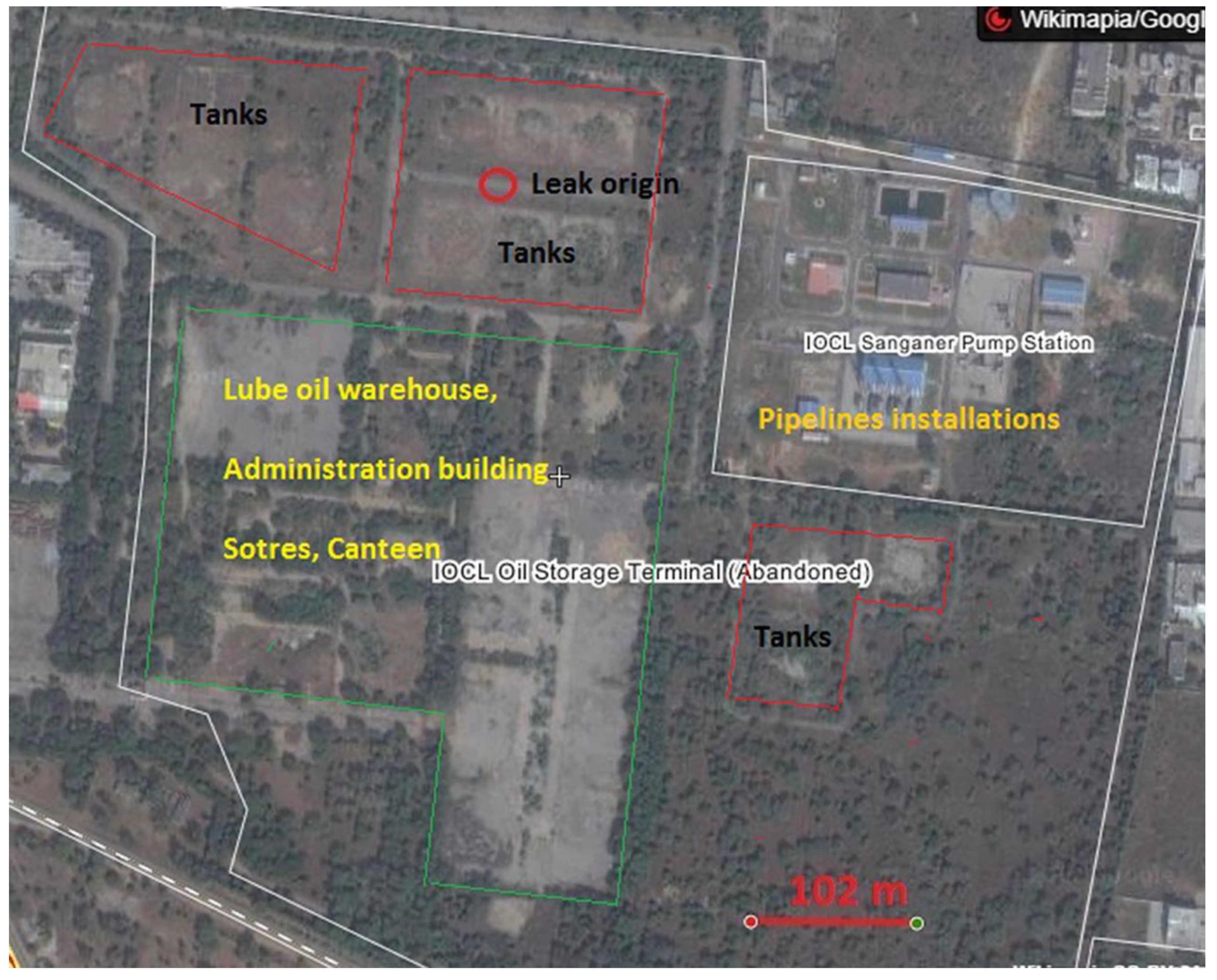
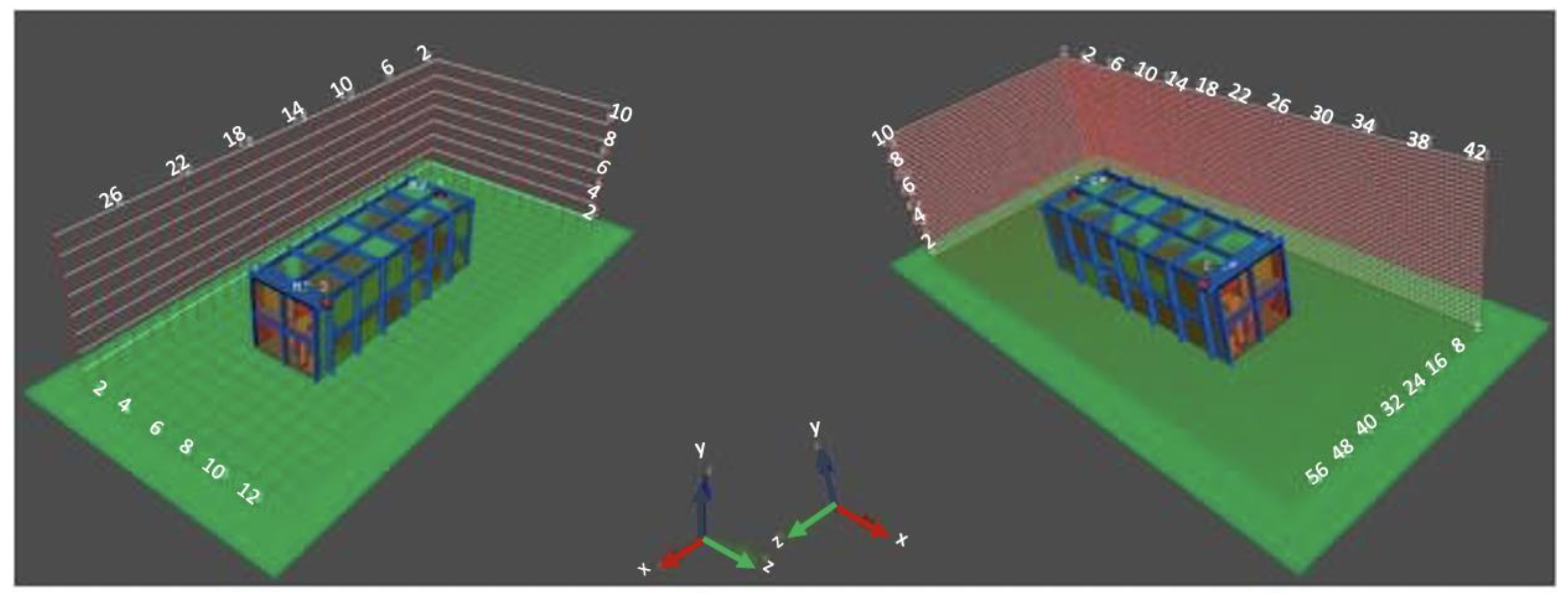
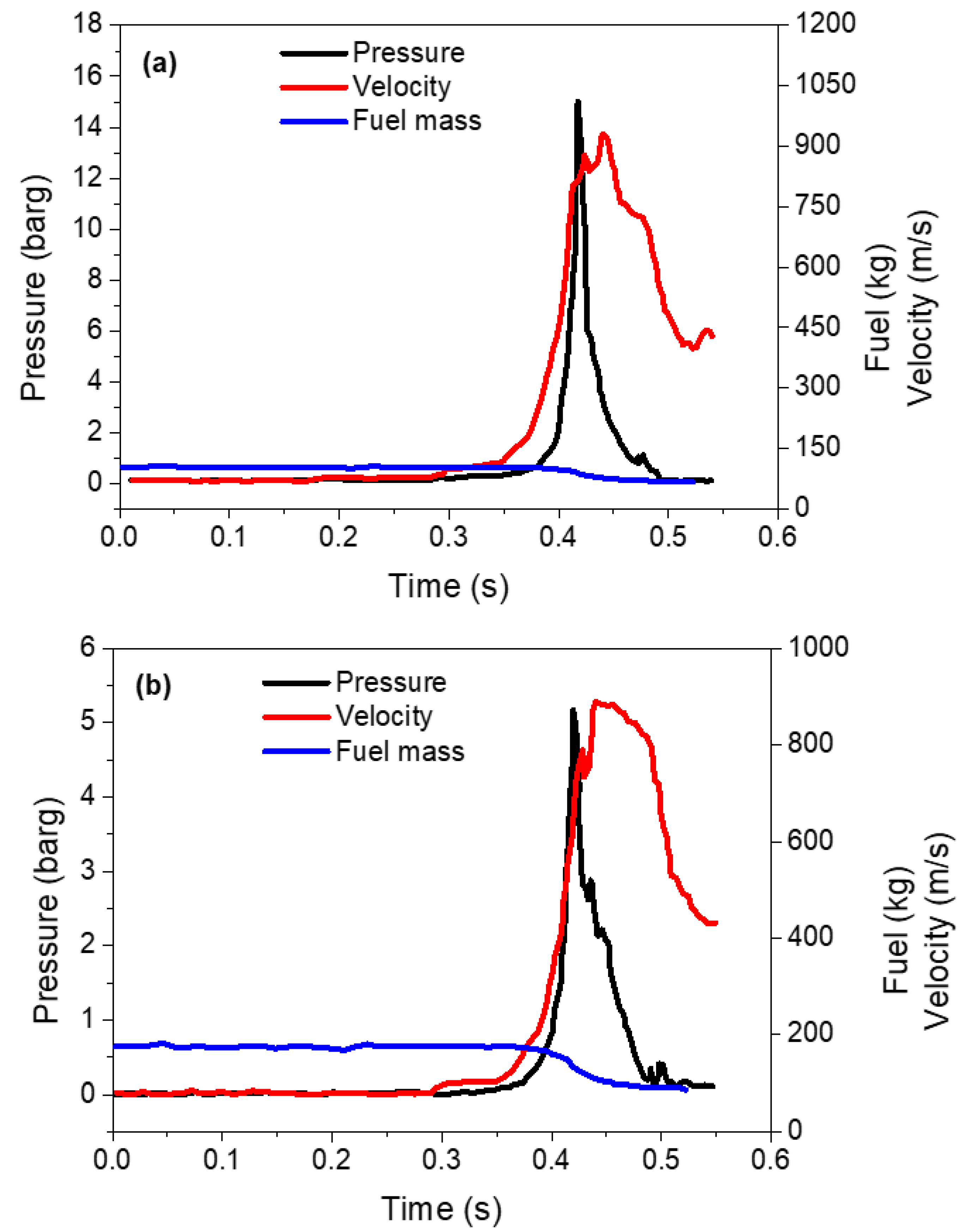

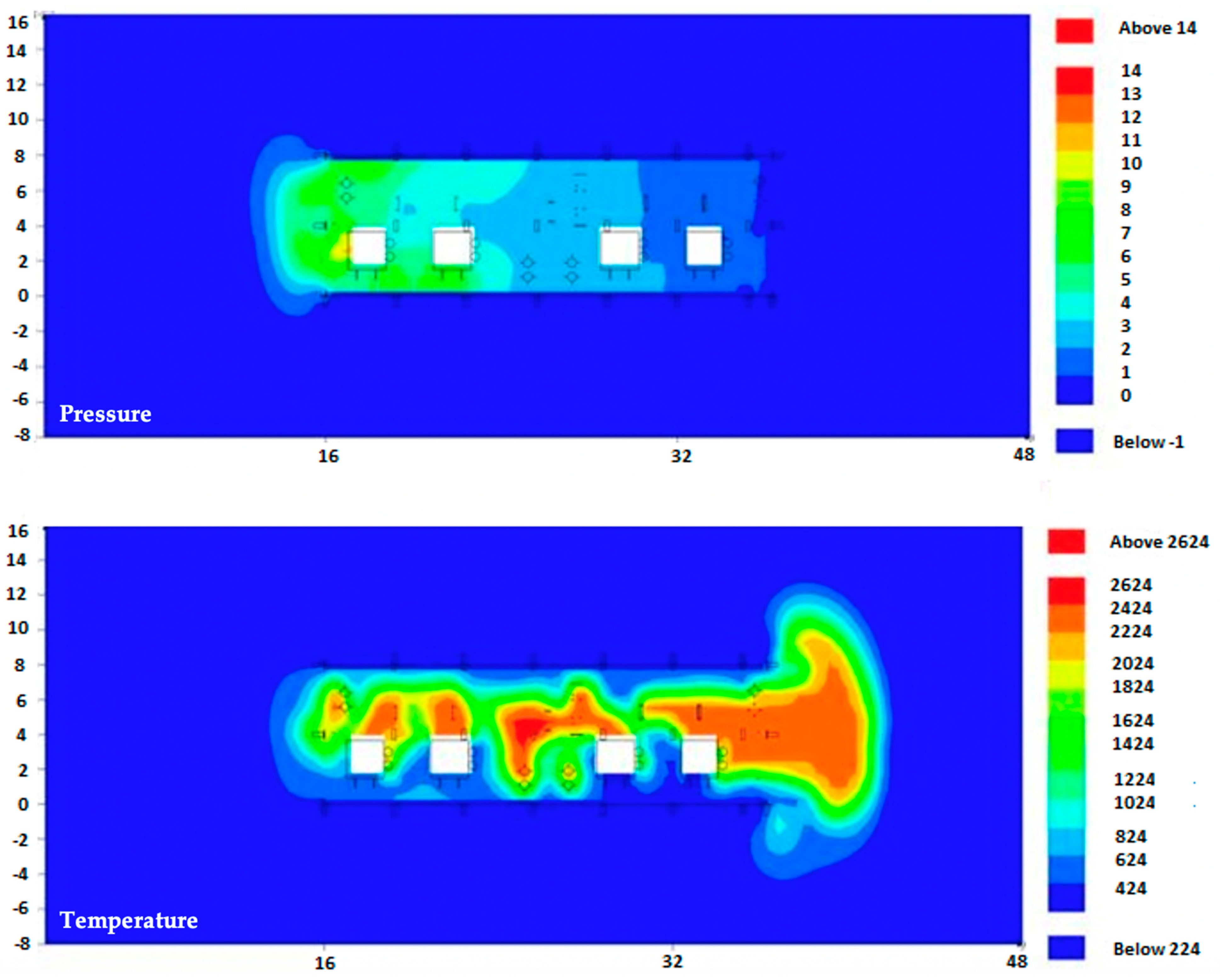
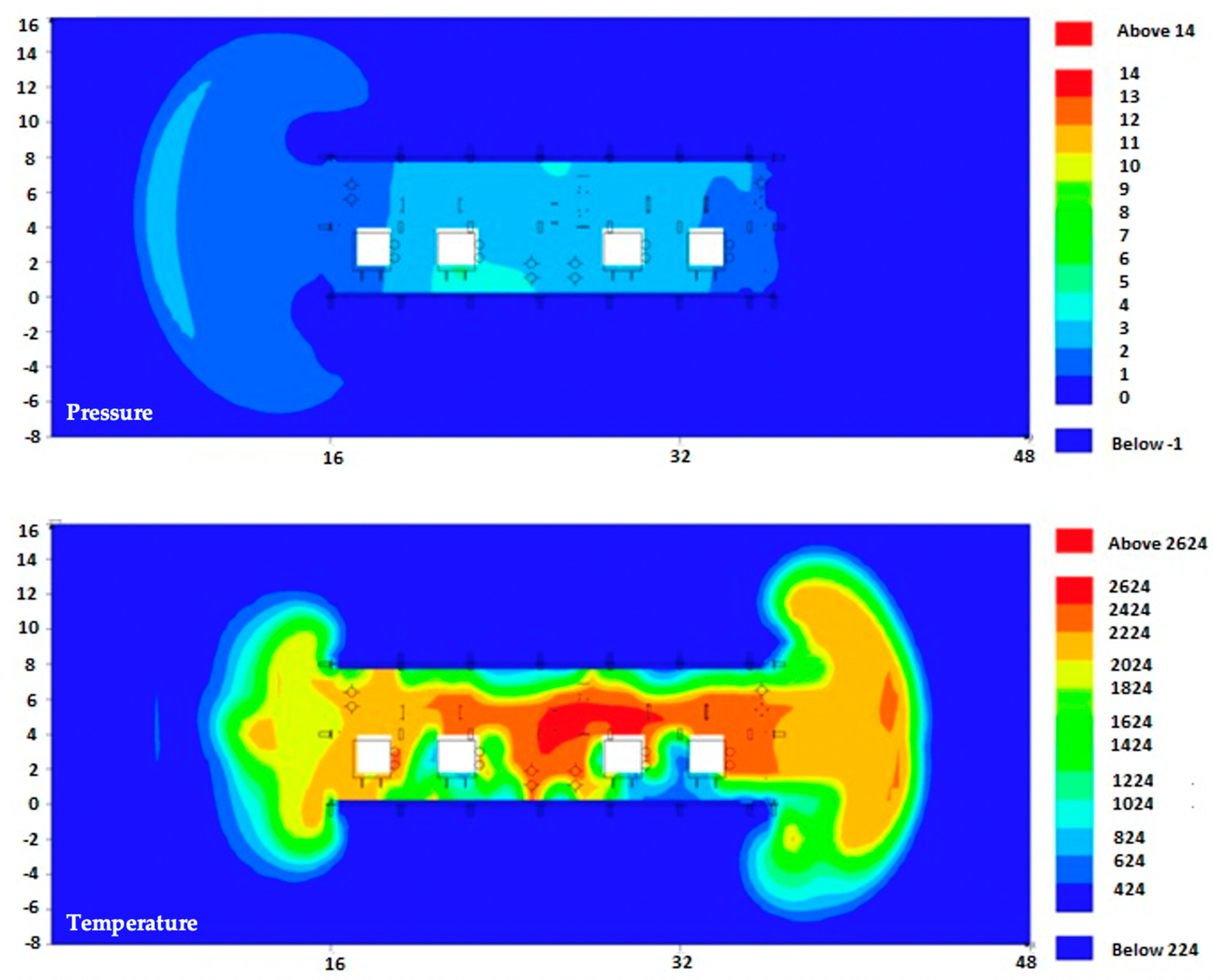

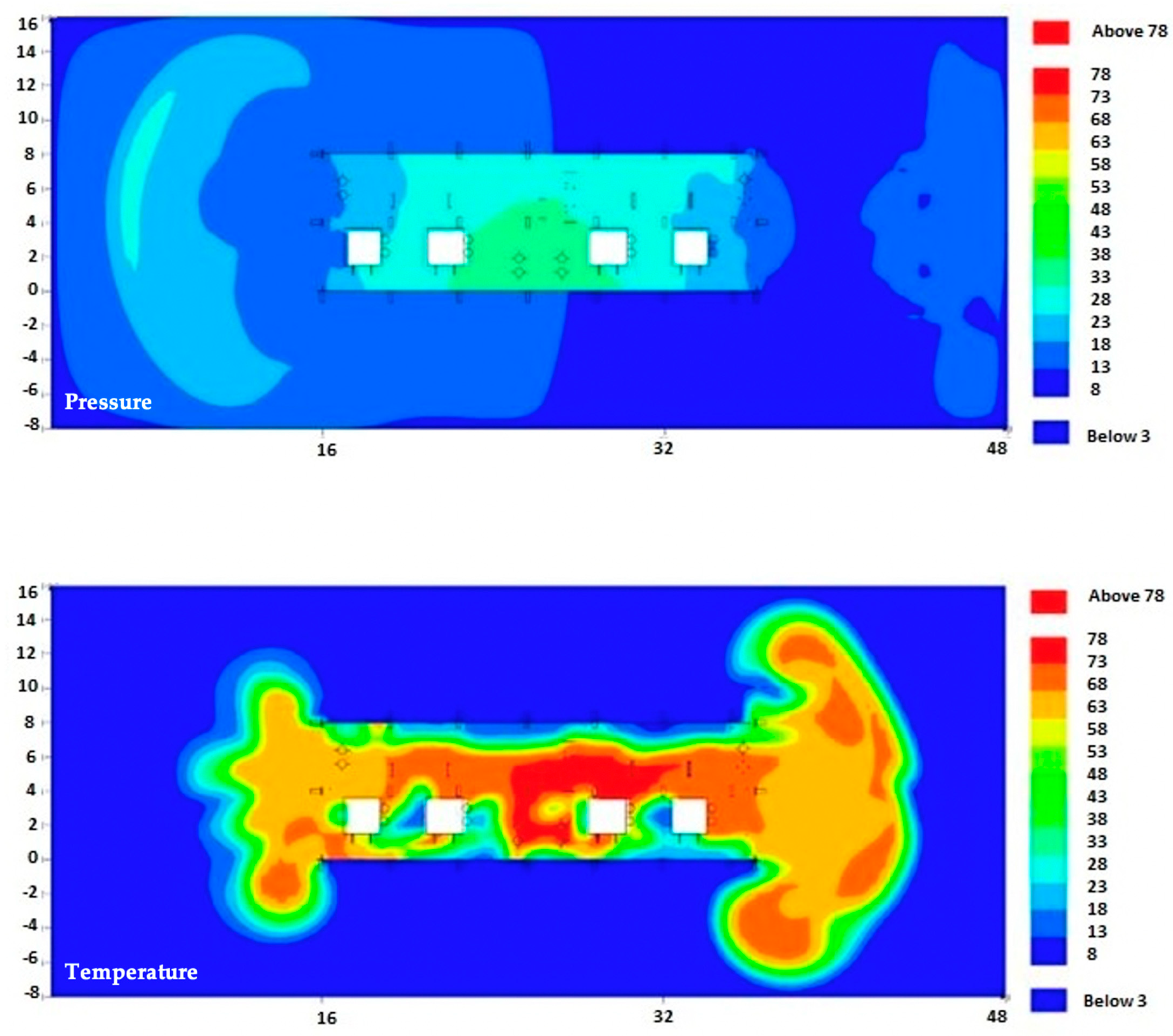
| Mesh | X | Y | Z |
|---|---|---|---|
| Coarse grid numbers | 28 | 12 | 8 |
| Fine grid numbers | 112 | 48 | 32 |
| Case Study | Highest Pressure for (bar (g)) | |
|---|---|---|
| A Fine Mesh | A Coarse Mesh | |
| Case1 Octane | 15.00 | 8.00–8.50 |
| Case2 Octane | 5.25–5.50 | 3.00–3.25 |
| Case 1 Natural gas | 7.50–8.00 | 5.50–6.00 |
| Case 2 Natural gas | 4.00 | 1.70–2.00 |
Publisher’s Note: MDPI stays neutral with regard to jurisdictional claims in published maps and institutional affiliations. |
© 2021 by the authors. Licensee MDPI, Basel, Switzerland. This article is an open access article distributed under the terms and conditions of the Creative Commons Attribution (CC BY) license (https://creativecommons.org/licenses/by/4.0/).
Share and Cite
Sajid, Z.; Khan, M.K.; Rahnama, A.; Moghaddam, F.S.; Vardhan, K.; Kalani, R. Computational Fluid Dynamics (CFD) Modeling and Analysis of Hydrocarbon Vapor Cloud Explosions (VCEs) in Amuay Refinery and Jaipur Plant Using FLACS. Processes 2021, 9, 960. https://doi.org/10.3390/pr9060960
Sajid Z, Khan MK, Rahnama A, Moghaddam FS, Vardhan K, Kalani R. Computational Fluid Dynamics (CFD) Modeling and Analysis of Hydrocarbon Vapor Cloud Explosions (VCEs) in Amuay Refinery and Jaipur Plant Using FLACS. Processes. 2021; 9(6):960. https://doi.org/10.3390/pr9060960
Chicago/Turabian StyleSajid, Zaman, Muhammad Kashif Khan, Alireza Rahnama, Farzan Sahari Moghaddam, Kirti Vardhan, and Reema Kalani. 2021. "Computational Fluid Dynamics (CFD) Modeling and Analysis of Hydrocarbon Vapor Cloud Explosions (VCEs) in Amuay Refinery and Jaipur Plant Using FLACS" Processes 9, no. 6: 960. https://doi.org/10.3390/pr9060960
APA StyleSajid, Z., Khan, M. K., Rahnama, A., Moghaddam, F. S., Vardhan, K., & Kalani, R. (2021). Computational Fluid Dynamics (CFD) Modeling and Analysis of Hydrocarbon Vapor Cloud Explosions (VCEs) in Amuay Refinery and Jaipur Plant Using FLACS. Processes, 9(6), 960. https://doi.org/10.3390/pr9060960








